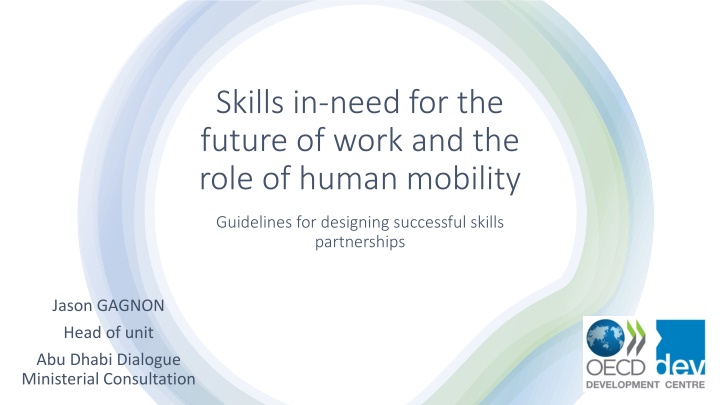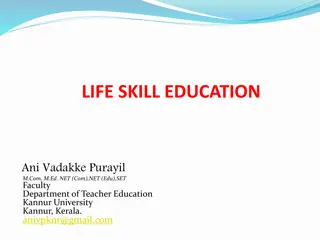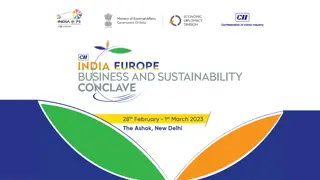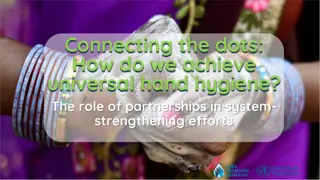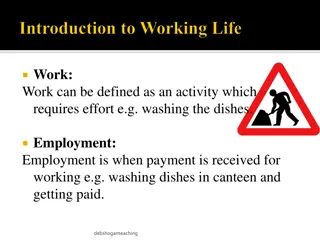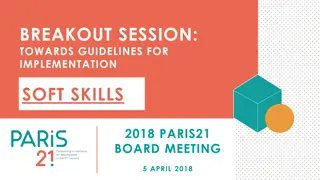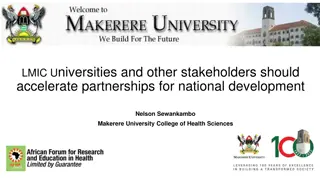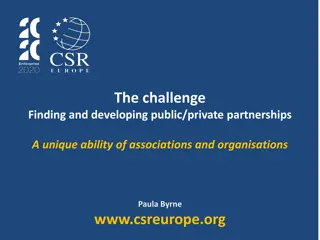Skills in Need for the Future of Work - Guidelines for Successful Partnerships
Addressing the global talent shortage and the importance of core skills like analytical thinking, creativity, resilience, adaptability, motivation, and technological literacy. Highlighting the critical role of digital skills in bridging the gap and the demand for green skills in the workforce. Emphasizing the need for investments in education and training to meet the evolving demands of the job market. Exploring the challenges and opportunities in developing skills partnerships for a sustainable future of work.
Download Presentation

Please find below an Image/Link to download the presentation.
The content on the website is provided AS IS for your information and personal use only. It may not be sold, licensed, or shared on other websites without obtaining consent from the author.If you encounter any issues during the download, it is possible that the publisher has removed the file from their server.
You are allowed to download the files provided on this website for personal or commercial use, subject to the condition that they are used lawfully. All files are the property of their respective owners.
The content on the website is provided AS IS for your information and personal use only. It may not be sold, licensed, or shared on other websites without obtaining consent from the author.
E N D
Presentation Transcript
Skills in-need for the future of work and the role of human mobility Guidelines for designing successful skills partnerships Jason GAGNON Head of unit Abu Dhabi Dialogue Ministerial Consultation
The global talent shortage risks the digital and green transitions NUMBER OF EMPLOYERS REPORTING DIFFICULTIES FILLING ROLES (IN PERCENT) (ManpowerGroup 2023) Global human talent shortage by 2030: 85 million (Korn Ferry 2018) 77 75 69 54 45 40 38 36 71% in Energy and Utilities companies 1. Analytical thinking 2. Creative thinking 3. Resilience & Adaptability 4. Motivation & Self-Awareness 5. Curiosity 6. Technological literacy Core Skills 2023 Core Skills 2023 2014 2015 2016 2018 2019 2021 2022 2023 WHERE IS THE DIGITAL SKILLS GAP THE WIDEST? (Wiley 2021) (WEF 2023) Education & Training Public Administration Health Care Construction Manufacturing Prof., Sci., & Tech. Services 45.60% 42.50% 7 million people will be missing by 2030 in the green economy 41.30% 29% 24.70% 24.30% Extraction 21% (BCG 2023)
Skilled labour is constrained in the GCC workforce Skilled labour is constrained in the GCC workforce High demand High demand for analytical, planning, analytical, planning, and supervisory supervisory roles (PwC 2023, Misk academy 2020) 57% 57% of ME workforce say green skills will be green skills will be more important more important (PwC 2023) Engineering degrees Engineering degrees are the 2 2nd nd most sought most sought- -after after qualification (Bayt.com and YouGov 2023) 50% of CEOs 50% of CEOs in the Middle East warn that labour / skill shortages labour / skill shortages will impact profitability (PwC 2023)
There is room for growth through more investment in digital skills There is room for growth through more investment in digital skills in GCC countries in GCC countries 77% of IT decision-makers Only 40% of students Only 40% of students study high high- -demand qualifications demand qualifications in Saudi-Arabia (Misk Academy 2020) Top academic qualifications sought in candidate (Bayt.com and YouGov 2023) Only one of the 10 skills Only one of the 10 skills GCC digital professionals cite most commonly matches the fastest matches the fastest- -growing skills globally growing skills globally (strategy&, 2017) in the UAE view this shortage as a threat to their business (Equinix 2022) 23% 23% 18% Engineering Business Management ICT UAE 46% KSA 58% QAT 60% KWT 75% Respondents who believe their country has a shortage of people with specialised skills (PwC 2022)
BROADLY DEFINED SKILLS MOBILITY SCHEMES Education exchange programmes TVET programmes Skills Mobility Partnerships Short-term employment opportunities in partner countries Education qualification recognition frameworks Seasonal work mobility programmes One-year university placement programmes
WHY CREATE SKILLS MOBILITY SCHEMES? > Skills mismatch in labour market is worsening > SMSs can fill labour and skills shortages in specific sectors in both countries of origin and destination. > Regularize migration > Address concerns about the impact of migration on both sides. Skills mobility schemes (SMSs) allow for: > Shared migration costs and benefits > Additional legal migration pathways > Larger skills pool in both countries of origin and destination > Better training capacity in countries of origin > Flexibility > Alignment of skills with labour markets (demand-driven) 6
BENEFITS OF SKILLS MOBILITY PARTNERSHIPS Country of Origin Host Country Address labour market mismatch Skill shortages Regularising migration: reap the benefits of labour migration Decrease Unemployment Increased human capital through skills transfer Remittances Both: Improved communication on public policy in the areas of migration, labour markets, education and training Migrant Improved skills sets Improved career prospects
Migration can contribute to enhancing development in countries of destination Immigration helps reduce skills mismatches Immigrants expand the domestic market Immigrants contribute to financing social protection systems Immigration can lead to increased innovation & entrepreneurship
WHAT ARE THE PRACTICALITIES OF PUTTING TOGETHER AN SMP? Pre-SMP Assessment of labour market skills shortages and demand in CoO and CoD Creation of SMP Coordination between co-operation development agency and employment agencies in partner countries Collaboration with private sector Inclusion of diaspora organisations and communities in programme design During SMP Adjustment of migration systems (creation of new pathways for migrants) Regular communication between all stakeholders involved in the SMP Post-SMP Reintegration in CoO Review and evaluation of SMP
REVIEW OF SKILLS MOBILITY SCHEMES Collection of information and data on skills migration schemes Global Skills Partnerships database EMN-OECD report, March 2022 MPF website IOM and ILO websites National government websites Objective Create a database of SMSs that are ongoing or were active from 2010-2023 Breakdown their ingredients, the commonalities, the divergences, distil different practices Investigate the developmental impact of SMSs in CoO Provide the SMP and GSP community with additional material on which to base their own programming (including on development of CoO)
Overview of the Database CoD CoD : : Germany (16), Belgium (6), Italy (5) CoO CoO : : Africa: Tunisia (13), Morocco (9), Nigeria (5) Asia: Viet Nam (7), India (7), The Philippines (5) Interregional: Interregional: 44 Regional: Regional: 12 Budget: Budget: Can reach 125 million Participant size: Participant size: 8 400 000
Distribution of SMSs by region of destination Total: 56 2 43 6 1 5 12
Distribution of SMSs by region of origin Total: 56 7 1 23 29 7 5
There is an increasing number of SMSs 30 24 25 23 20 15 11 10 5 0 Prior to 2010 2010-2018 2019-2023
HOW ARE SKILLS MOBILITY SCHEMES SIMILAR? HOW DO THEY DIFFER? Bilateral labour migration agreements different from traditional migration recruitment systems because they combine migration policies with skills skills development development and recognition policies, involve partnerships mutual mutual benefits benefits. partnerships at different levels and imply No single model of partnership prevails, but all No single model of partnership prevails, but all SMSs possess the following components: SMSs possess the following components: However, SMSs will necessarily vary in terms of: However, SMSs will necessarily vary in terms of: > > Formalised State cooperation, often between different ministries Cost-sharing structures; > Location of training; > Multi-stakeholder involvement, including the private sector, training international organisations and local institutions > Targeted sectors; institutions, > Targeted skills and skill levels; > Skills development, including technical and vocational training, internships, pre-departure training and/or soft skills training > Partners involved; university courses, > Implementing partner/s; > Responsibility for curriculum development; > Skills recognition, through the implementation of training standards > Selection process for participants; > Responsibility upon return > Mobility, in most cases for an internship/ traineeship 15
SKILL LEVELS TARGETED IN SMSs Unspecified 8% Low 17% High 34% Low and Mid 5% Mid and High 9% Mid 27% High Mid and High Mid Low and Mid Low Unspecified 17
WHERE ARE THE GAPS? WHAT ARE THE CHALLENGES? Gaps > Truly co-created initiatives from conception forward > Questions on sustainability and scalability > Strength of business case\mutual benefits > Definition of skills developed > Lack of monitoring and evaluation > Link with development in country of origin > Clear measure of success Major challenges reported Conducting research for labour market demand and skills mismatch Collaborating between public and private sector stakeholders Building trust between co-operating partners Forming stakeholder partnerships Matching candidates with employers Political commitment 18
What about development in the country of origin?
How does migration contribute to development in countries of origin? Invest in the development of skills in origin countries to foster the acumulation of human capital Help reduce remittance costs and invest in financial training Fund diaspora projects in countries of origin Develop return programmes oriented towards productive investment Remittances represent a source of finance for development Emigration acts as a safety valve for the labour market Diasporas are an enabler for social development Brain circulation helps strengthen human capital & innovation
Integrating components of migration and development into SMSs Labour market assessments: 73% Remittances & financial inclusion: 9% Return & reintegration: 54% Diaspora stakeholders: 9% 21
Capacity Building (36%) Education Institutions: dialogue and exchanges Capacity Building Data Management 22
Training in CoO (14%) Home Track Address skills needs of CoO Dual Track Away Track Address skills needs of CoD Cultural and language training
National development strategies (9%) Sectoral Plans Development Strategies\nati onal priorities Skills mobility schemes
Biggest gap: Integrating SMSs into the broader picture Green Transition National development plans Future of work New technologies
